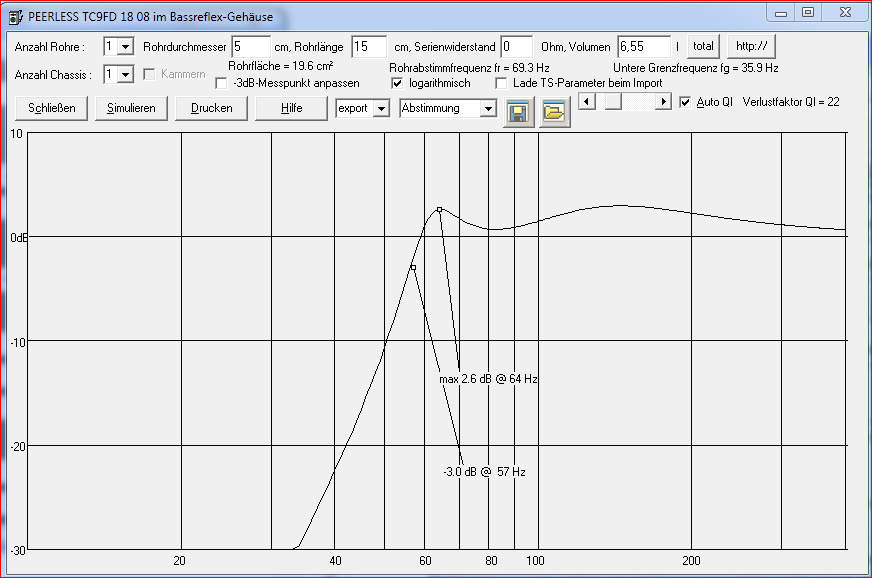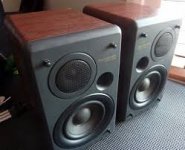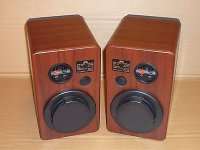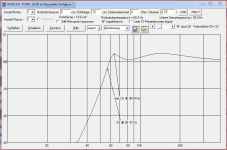Hi All
I am preparing to build my first speakers with 4’ drivers I have Faital 4FE35 FaitalPRO | LF Loudspeakers | 4FE35
In-order to get optimum Low frequencies I have the following questions:
1. I understood that the volume for this driver should be 6,7 Lt for sealed enclosure and a little more for Bass reflex. Is this correct?
2. Is this volume considered for each driver? If I decide do build a speaker with 2 or 4 of same drivers I will have to multiply the volume per each drive?
3. I intent to use MDF or Akoume Plywood. Which of the 2 material gives optimum Low frequencies and on what thickness?
Thank you
I am preparing to build my first speakers with 4’ drivers I have Faital 4FE35 FaitalPRO | LF Loudspeakers | 4FE35
In-order to get optimum Low frequencies I have the following questions:
1. I understood that the volume for this driver should be 6,7 Lt for sealed enclosure and a little more for Bass reflex. Is this correct?
2. Is this volume considered for each driver? If I decide do build a speaker with 2 or 4 of same drivers I will have to multiply the volume per each drive?
3. I intent to use MDF or Akoume Plywood. Which of the 2 material gives optimum Low frequencies and on what thickness?
Thank you
In-order to get optimum Low frequencies I have the following questions:
1. I understood that the volume for this driver should be 6,7 Lt for sealed enclosure and a little more for Bass reflex. Is this correct?
Not by my lights it isn't, but it depends on whom has told you these volumes and exactly what their reasoning (if any) was. The sealed is ok-ish; 'a little more for bass reflex' rather depends on exactly what 'a little more' means, and what the tuning is. There isn't any especially good tuning around that volume from my POV, & the driver's Q is really a bit high for a conventional vented box. You can make it work, but it's not ideal for a stock vented.
2.Is this volume considered for each driver? If I decide do build a speaker with 2 or 4 of same drivers I will have to multiply the volume per each drive?
Assuming no other changes & identical drivers, 1 driver uses x volume, so 2 drivers will require 2x volume, 3 drivers will require 3x & so on.
3. I intent to use MDF or Akoume Plywood. Which of the 2 material gives optimum Low frequencies and on what thickness?
Construction material doesn't give low frequencies unless you happen to be an expert instrument builder & design it to resonate (and then only play music from that specific instrument, as it won't be appropriate for anything else). The driver and acoustic loading do that. A quality void free plywood is generally superior to MDF for bass enclosures as it usually has a greater MOE value & its resonant modes are thus less likely to be in or near the main box operating region. For a small box 12mm is OK; personally I prefer 18mm as a default but that's just me.
Good 12mm ply will be fine. The cheap stuff might have 5-6 layers, and they'll be broken up and overlap/merge into each other. The good stuff usually has more layers, and they're all straight and parallel with no voids.
Most of my speaker building is in live sound, where weight is a consideration, so I usually go for thinner materials and make up the strength with bracing.
Chris
Most of my speaker building is in live sound, where weight is a consideration, so I usually go for thinner materials and make up the strength with bracing.
Chris
Not by my lights it isn't, but it depends on whom has told you these volumes and exactly what their reasoning (if any) was. The sealed is ok-ish; 'a little more for bass reflex' rather depends on exactly what 'a little more' means, and what the tuning is. There isn't any especially good tuning around that volume from my POV, & the driver's Q is really a bit high for a conventional vented box. You can make it work, but it's not ideal for a stock vented.
Thank you your reply.
I found this volumes on Parts express site
FaitalPRO 4FE35 4" Professional Full-Range Woofer 4 Ohm
and also I've seen some other sites with calculation standars when puting the specs of the driver.
My question is what would be the ideal volume for the driver inorder to get optomim low frequaancies.
i guess I will be using Plywood if I dont make them spherical
Hi guys
I am confused with the volume issue and I need again some help ..
The specific 4 inch drivers (FaitalPRO 4FE35 4" Professional Full-Range Woofer 4 Ohm) could be installed in sealed enclosures.
Due to the fact that they are small it is important to give the ideal space inorder to obtain optimum low frequencies.
I kindly need your advice because I think 0,23 cubic feet which is 6,7liters for sealed enclosures and 0,24 cubic feet which is 6,8 liters for vented bit large for a 4 inch full range driver. We want to obtain the optimum low frequencies; can you tell me what should be the ideal volume for those drivers?
Referring to an 8 inch driver (FaitalPRO 8FE200 8" Professional Midbass 8 Ohm) where the volume noted is 0,76 cubic feet which is 21,5 liters and 1,21 which is 34,2 liters. I intent to use that one on another 2 way project but I am mentioning this here because the issue of the volume is not irrelevant.
But In general the spherical enclosures (and not only) that I see in the internet are not so large to have 21,5 for sealed or 34,3 liters for vented net volume. What should be the ideal volume??
Many of them use bamboo bowl which is small for this volume. Is the bamboo material comparable to plywood or MDF ?
Thank you
I am confused with the volume issue and I need again some help ..
The specific 4 inch drivers (FaitalPRO 4FE35 4" Professional Full-Range Woofer 4 Ohm) could be installed in sealed enclosures.
Due to the fact that they are small it is important to give the ideal space inorder to obtain optimum low frequencies.
I kindly need your advice because I think 0,23 cubic feet which is 6,7liters for sealed enclosures and 0,24 cubic feet which is 6,8 liters for vented bit large for a 4 inch full range driver. We want to obtain the optimum low frequencies; can you tell me what should be the ideal volume for those drivers?
Referring to an 8 inch driver (FaitalPRO 8FE200 8" Professional Midbass 8 Ohm) where the volume noted is 0,76 cubic feet which is 21,5 liters and 1,21 which is 34,2 liters. I intent to use that one on another 2 way project but I am mentioning this here because the issue of the volume is not irrelevant.
But In general the spherical enclosures (and not only) that I see in the internet are not so large to have 21,5 for sealed or 34,3 liters for vented net volume. What should be the ideal volume??
Many of them use bamboo bowl which is small for this volume. Is the bamboo material comparable to plywood or MDF ?
Thank you
Give us chance, we can't all be here 24/7.
There is no fixed / absolute 'optimum', as this is a floating point that depends on your design goals. Do you want me to be honest? If so, then for many vented alignments, this driver is essentially incapable of producing much in the way of LF output. It's not designed for it & not particularly well optimised for it. Simple as. If bass is your requirement, you would be better off with another driver. As for volumes, for a sealed box with the lowest possible F3, you would technically need a much larger enclosure than you think -actually in excess of 40 litres, which is completely impractical. If you can put up with a slightly higher F3, then 6 litres will put you in the mid 0.9 Qtc regions. As far as normal vented boxes are concerned, there are no quality alignments available, although with some creativity & shifting to a highly damped box & quasi-TL alignment something reasonable can be achieved. The question then becomes whether it's worth the effort when other drivers exist that can produce more on the bottom end without requiring a lot of extra work.
Bamboo plywood, assuming it is void-free, is typically superior to MDF and good examples have an edge over birch ply as well.
There is no fixed / absolute 'optimum', as this is a floating point that depends on your design goals. Do you want me to be honest? If so, then for many vented alignments, this driver is essentially incapable of producing much in the way of LF output. It's not designed for it & not particularly well optimised for it. Simple as. If bass is your requirement, you would be better off with another driver. As for volumes, for a sealed box with the lowest possible F3, you would technically need a much larger enclosure than you think -actually in excess of 40 litres, which is completely impractical. If you can put up with a slightly higher F3, then 6 litres will put you in the mid 0.9 Qtc regions. As far as normal vented boxes are concerned, there are no quality alignments available, although with some creativity & shifting to a highly damped box & quasi-TL alignment something reasonable can be achieved. The question then becomes whether it's worth the effort when other drivers exist that can produce more on the bottom end without requiring a lot of extra work.
Bamboo plywood, assuming it is void-free, is typically superior to MDF and good examples have an edge over birch ply as well.
I find that sealed from 6-12 liters looks decent enough for this driver. Much better than what any vented alignment would produce as Scott said. It's already good to hit f3<100Hz on a 4" of decent sensitivity IMO. You could always use some EQ to bring up the bottom end a bit. Personally, I'd go for a smaller box as the difference is not dramatic unless you go ridiculously large.
Is there a specific reason you link to or are planning to use the 4 Ohm version? The 8 Ohm version does have 1mm more Xmax, which could help towards a bit more headroom if you choose to EQ. It would net you ~2dB more under 200Hz. It has a higher Qtc and will have a lower f3 in the same Vb, but since the 4 Ohm driver's Qtc is aleady above 0.7, I look at them as fairly equivalent.
Is there a specific reason you link to or are planning to use the 4 Ohm version? The 8 Ohm version does have 1mm more Xmax, which could help towards a bit more headroom if you choose to EQ. It would net you ~2dB more under 200Hz. It has a higher Qtc and will have a lower f3 in the same Vb, but since the 4 Ohm driver's Qtc is aleady above 0.7, I look at them as fairly equivalent.
Last edited:
First of all I thank you for your help.
I am not good in this type of calculations and your help is important to me. That is why I repeated my message trying to explain better my questions.
There is no big choice of 4inch drivers locally so I found those ones and I believe they are good. I am not using an equalizer when listening to music. I like flat stereo HiFi.
The drivers I already have are 8Ωhm.
At the beginning I indented to get a pair of them inorder to replace the woofers of 2way bookshelf old Sansui speakers (J-11) SANSUI J11
Finally I did purchased 4 of them with the intention to put them in parallel in the Sansui enclosure by removing the crossover the tweeter and the passive radiator.
But after reading specs and searching about frequencies I understood that with larger sealed enclosure I’ll get much better sound (volume of 6,7ltX2 would be abox of something like 20x28x24cm net). Note that Sansui net volume is much bellow 4liters. So would start building a plywood sealed enclosure on which I’ll put a massif thick piece of wood glued on the plywood just in the front.
Then I would get another woofer (a 4Ωhm low range probably) to connect with actual Sansui box.
Referring to the 8inch driver for the other project If I am not mistaken a bassreflex box would be an ideal enclosure? and the volume should be 35liters F3 52Hz. If I consider a simple square enclosure that would be : 32X32X32cm but then the dimension of spherical enclosure should be 40cm net diameter (if I am not mistaken on my calculations!).. .
But most of the spherical bamboo enclosure I see on the internet have 28 cm diameter. much smaller
What do you think about all this?
I am not good in this type of calculations and your help is important to me. That is why I repeated my message trying to explain better my questions.
There is no big choice of 4inch drivers locally so I found those ones and I believe they are good. I am not using an equalizer when listening to music. I like flat stereo HiFi.
The drivers I already have are 8Ωhm.
At the beginning I indented to get a pair of them inorder to replace the woofers of 2way bookshelf old Sansui speakers (J-11) SANSUI J11
Finally I did purchased 4 of them with the intention to put them in parallel in the Sansui enclosure by removing the crossover the tweeter and the passive radiator.
But after reading specs and searching about frequencies I understood that with larger sealed enclosure I’ll get much better sound (volume of 6,7ltX2 would be abox of something like 20x28x24cm net). Note that Sansui net volume is much bellow 4liters. So would start building a plywood sealed enclosure on which I’ll put a massif thick piece of wood glued on the plywood just in the front.
Then I would get another woofer (a 4Ωhm low range probably) to connect with actual Sansui box.
Referring to the 8inch driver for the other project If I am not mistaken a bassreflex box would be an ideal enclosure? and the volume should be 35liters F3 52Hz. If I consider a simple square enclosure that would be : 32X32X32cm but then the dimension of spherical enclosure should be 40cm net diameter (if I am not mistaken on my calculations!).. .
But most of the spherical bamboo enclosure I see on the internet have 28 cm diameter. much smaller
What do you think about all this?
Adding damping material to a sealed enclosure makes it look like it's larger than it is and thus lowers the Qtc, but as there is no free lunch, f3 is proportionally raised and output diminished. As far a Qtc in absolute terms, I guess few people would argue that 0.707 isn't good, but opinions vary from 0.5 to 1.0, likely with a few "nutjobs"  going beyond. The average person probably would prefer something in the 0.8-1.0 range though.
going beyond. The average person probably would prefer something in the 0.8-1.0 range though.
Using 2" fiberglass lining on the walls and polyfill in the center, I once experimentally determined that the apparent enclosure volume can be raised by about 33% as far as the diminution of Qtc goes. More than this and it was too dense and actually started to raise Qtc again. I figured that in WinISD, my stuffing was equivalent to Qa parameter of ~8.
I encourage you to download and simulate your drivers in an enclosure software such as WinISD, it's very enlightening and a big part of how I learned about this stuff.
Using 2" fiberglass lining on the walls and polyfill in the center, I once experimentally determined that the apparent enclosure volume can be raised by about 33% as far as the diminution of Qtc goes. More than this and it was too dense and actually started to raise Qtc again. I figured that in WinISD, my stuffing was equivalent to Qa parameter of ~8.
I encourage you to download and simulate your drivers in an enclosure software such as WinISD, it's very enlightening and a big part of how I learned about this stuff.
Last edited:
I am not very good in all these calculations. I will find and try this software thank you.
I am thinking to build speakers with 2 drivers sealed. how much space do I have to give behind the drivers? the volume is for 14 liters but If I put 1inch of dumping material to the walls how much the volume could be reduced?
I am thinking to build speakers with 2 drivers sealed. how much space do I have to give behind the drivers? the volume is for 14 liters but If I put 1inch of dumping material to the walls how much the volume could be reduced?
Somebody may help me to understand the way a JVC shelf speaker drivers are connected inside because when I opened I found no crossover but a tweeter of 8Ω 30W, a mid-range of 8Ω 15W and a (strange)woofer in the back of the enclosure also 8Ω 15W. there only a capacitor connected to the tweeter. The model of the speaker is SP UXD88 4Ω 30W
Thank you
Thank you
Attachments
The lack of any visible LP filter on the bass drivers may simply mean the design team assessed they have sufficiently smooth roll-off to not require any, and that tweeter was rugged enough to survive with a first order electrical function at the selected crossover point. Nothing new there, really.
...I found no crossover... there only a capacitor connected to the tweeter.
As Chris implies, that capacitor is the entirety of the crossover.
dave
I am preparing to decide the type (sealed or Vented) enclosure and dimensions too. for the 4 inch Faital
FaitalPRO 4FE35 4" Professional Full-Range Woofer 8 Ohm
I read that the optimum volume for sealed would be 5,66 lit and it indicates a Fs of 100Hz, and for vented would be 8,28 lit with the indication of lower Fs to 59 Hz,
Does this mean that the driver produce more bass frequencies with vented enclosure to that volume?
and do I have to add dumping material inside to get this result?
Thank you
FaitalPRO 4FE35 4" Professional Full-Range Woofer 8 Ohm
I read that the optimum volume for sealed would be 5,66 lit and it indicates a Fs of 100Hz, and for vented would be 8,28 lit with the indication of lower Fs to 59 Hz,
Does this mean that the driver produce more bass frequencies with vented enclosure to that volume?
and do I have to add dumping material inside to get this result?
Thank you
Last edited:
I did a quick and dirty sim for your Faital in a rather small vented enclosure with 150x190x230mm internal dimensions and a vent with 50mm diameter and 150mm lenght:

Don't let the chassis name in the picture mislead you - the sim is for your Faital...
Maybe this helps you
Don't let the chassis name in the picture mislead you - the sim is for your Faital...
Maybe this helps you
Attachments
Last edited:
"Some questions for my first 4 inch".....
That's a nice text ....
Made my day - thanks!
- Status
- This old topic is closed. If you want to reopen this topic, contact a moderator using the "Report Post" button.
- Home
- Loudspeakers
- Full Range
- Some questions for my first 4 inch


